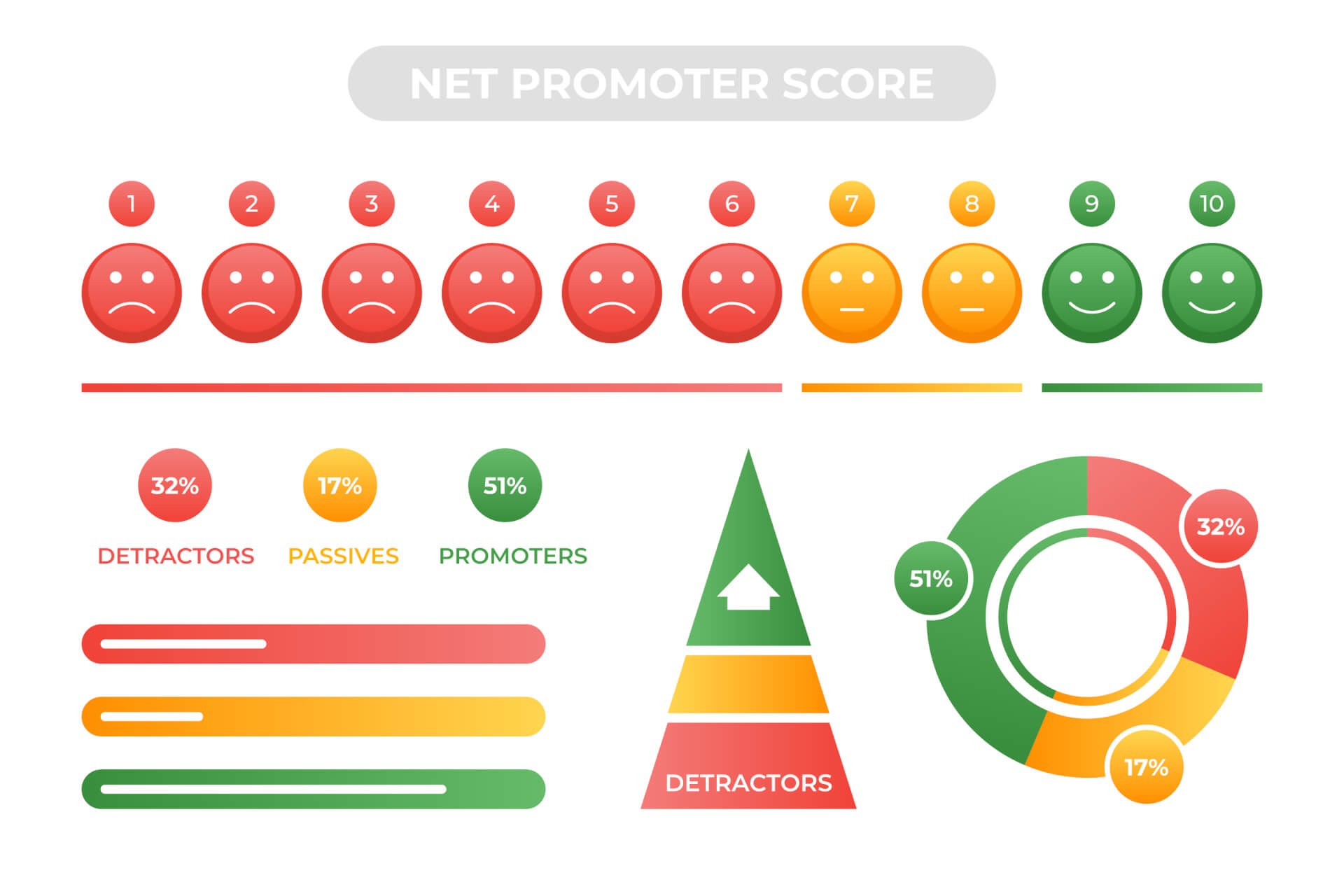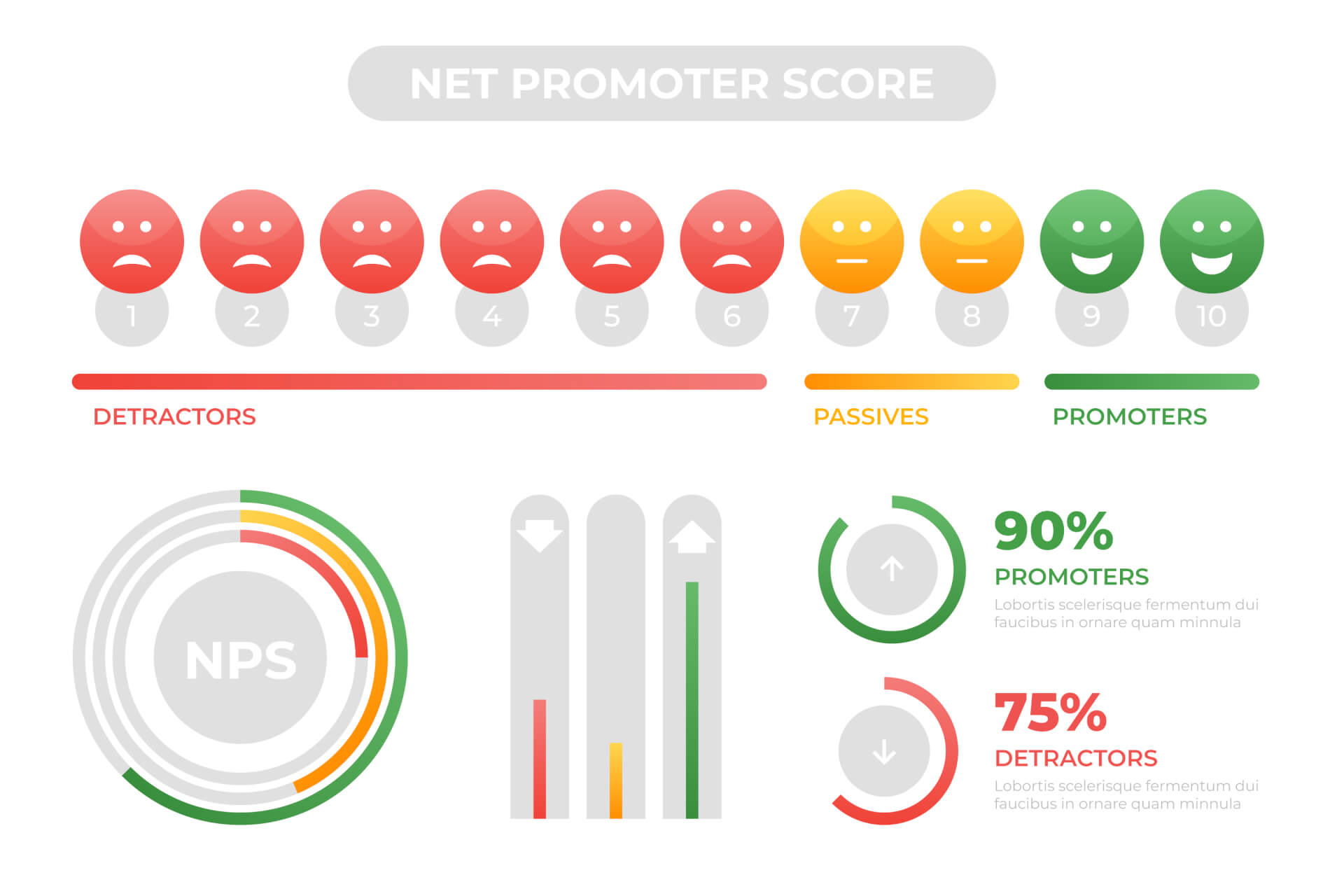Many of the world's largest companies use the Net Promoter Score® to measure and track customer sentiment. Most swear on NPS® as the most accurate and effective means of measuring customer loyalty and satisfaction.
But what if you are not one of the largest companies in the world? What value can NPS bring to your business?
Most people associate Net Promoter Score with big business because it is used by big brands and Fortune 500 companies. Bain & Company, who developed NPS, estimates that two-thirds of the Fortune 1000 use the Net Promoter Score to track customer satisfaction and retention.
However, the popularity of the Net Promoter Score among large companies does not mean that it is less useful for sole proprietorships - on the contrary. As a small, one-person business, you can benefit even more from using the Net Promoter Score to assess customer satisfaction.

Table of Contents
- Why you as a small business owner benefit from the NPS
- Value qualitative feedback as much as you value your NPS
- Sort the feedback to see what your customers like best
- Use a low score as an opportunity to win back critics
- Understand the statistical significance and margin of error
- Use NPS to retain customers and generate further referrals
Why you as a small business owner benefit from the NPS
 As an individual, you receive feedback directly from customers and can take action almost immediately. If a customer is unhappy, you can get in touch immediately.
As an individual, you receive feedback directly from customers and can take action almost immediately. If a customer is unhappy, you can get in touch immediately.
When customers are very happy, you can get in touch directly to thank them for working with us. This speed is an advantage that larger companies don't have.
Approximately 65% of new business comes from referrals, which makes word of mouth your most valuable marketing channel. Since you don't have the multi-million dollar marketing budget of a Fortune 1000 brand, maximizing referrals from happy customers is a great way to attract new customers and grow your service business.
The Net Promoter Score gives you an accurate overview of the quality of your service, which comes from a diverse sample of your customers. By tracking your company's NPS, you will gain extensive knowledge of its strengths and weaknesses.
Establishing the Net Promoter Score in your company is easy, and implementing the NPS principles can also bear fruit immediately. In the lines below, we've outlined a simple process for using NPS that can help you learn more about your customers, get more referrals, and generate more business.
Value qualitative feedback as much as you value your NPS
 When you use an NPS service to send a survey to your customers, you get both a quantitative rating (a rating from 1 to 10 of the likelihood that the customer will recommend you to their friends or colleagues) and qualitative feedback.
When you use an NPS service to send a survey to your customers, you get both a quantitative rating (a rating from 1 to 10 of the likelihood that the customer will recommend you to their friends or colleagues) and qualitative feedback.
For a service provider, the qualitative feedback you receive is just as valuable - and perhaps even more valuable - as the score that each customer gives you. The reason for this is simple: a score explains what each customer thinks of your service. The written feedback explains why they have this impression. By engaging with the qualitative feedback you get from interviewing your customer, you will learn why customers like your service and what they don't.
For example, analyzing the feedback you receive from event organizers is a good cross-section of the strengths of your service. Check out what customers love about your service and discover the key core competencies you offer. This gives you clear advantages that you can communicate to new prospects.
Review what Passives have to say about your service and discover opportunities for improvement that can help you promote Passive customers. Reviewing feedback from critics will reveal your greatest weaknesses and clear problem areas where improvement is imperative. As a service professional, one of your advantages is the ability to respond quickly to precise feedback. Take qualitative feedback seriously and don't make the mistake of viewing NPS as a fully quantitative metric.

Reading recommendation: Quality feedback is important for increasing customer satisfaction. Our blog article shows you “Actions you can take if you don’t receive quality NPS feedback”
Sort the feedback to see what your customers like best
 If you have an active base of 100+ customers, you can sort their feedback into categories to see what they love most about your service.
If you have an active base of 100+ customers, you can sort their feedback into categories to see what they love most about your service.
For example, using this tactic may reveal that, for example, the simple user interface is the feature that your customers value most. By sorting the feedback you get from customers, you can find out which aspects of your service have the greatest positive impact on average customer satisfaction. It can also help you find ways to improve your service to get more sales while getting better feedback.
For example, if customers rate price as the aspect of your service they like the most, and at the same time have complaints about the quality of the service, you can conclude that an increased focus on quality is a wise investment, even if it translates into a slight increase in price. In addition to sorting and categorizing feedback, it's equally important to sort and categorize the sources of your feedback. If you have a diverse customer base - small businesses, individuals, and larger companies, for example - sort their feedback into categories based on the type of business.
By sorting both your feedback and your feedback sources into categories, you'll find out which types of customers are ideal and which don't suit your business.
Use a low score as an opportunity to win back critics
 As an individual, rather than part of a large corporation, you are in a great position to take quick action and win customers back after receiving negative feedback.
As an individual, rather than part of a large corporation, you are in a great position to take quick action and win customers back after receiving negative feedback.
An amazing 89% of customers say they would switch to a competitor after having a bad experience. Respond quickly and positively and you could win back a large percentage of angry or disappointed customers and even turn many into valuable promoters. This is known as "Close-The-Loop" and is an important part of customer loyalty. When a customer provides feedback through NPS, they enter a loop. With this loop technique, you can learn from the feedback received and then use that input to improve your service.
In our other articles we have already addressed the relevance of the "close-the-loop" technique several times. Always try to excite critics by offering to fix the issues highlighted (or better yet, delivering a customer experience that exceeds their expectations) and you will win back many of them. As a service provider, individual customers can have significant service life value. Act quickly if you find a customer is a critic and you can turn them into a valuable, avid promoter.
Understand the statistical significance and margin of error
Since one-person service providers have far fewer customers than the average company, it's important to understand how a lack of statistical significance can affect your Net Promoter Score.
When surveying a small audience, statistical noise - unexplained variances that arise from a small sample - can affect your data. The smaller your audience, the higher the noise level, causing large fluctuations in your Net Promoter Score. Before assigning too much value to a single month's Net Promoter Score, calculate the margin of error based on the size of your survey group. If your customer base is small, it will take longer to get a statistically significant Net Promoter Score.

Reading recommendation: Our blog article “Is Your Net Promoter Score Skewed?” deals with the topic of evaluating and understanding the NPS score more in detail.
Use NPS to retain customers and generate further referrals
As a freelancer, consultant, or service professional, Net Promoter Score is an extremely effective tool for engaging customers, learning how people think about your service, and increasing the number of referrals you get.
Callexa Feedback helps you automate the Net Promoter Score so you can generate valuable feedback from customers while you focus on running your business. Register today and start your first NPS campaign.
 Reading recommendation: If this article helped you and you would like to find out more about the Net Promoter Score, continue reading here: “The Net Promoter Score – Basics and Areas of Application”
Reading recommendation: If this article helped you and you would like to find out more about the Net Promoter Score, continue reading here: “The Net Promoter Score – Basics and Areas of Application”